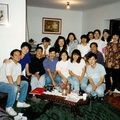I'm in the middle of Pará state, about three hours from the large city of Belém on a dirt road three hours from a small village called Tomé Açu.
Tomé Açu was one of several Japanese farming colonies in the state that started with the arrival of 43 Japanese families in 1929. This farming community would emerge successfully through the cultivation of pepper. The fortunes of the community would also decline as the pepper plant fell victim to a fungus that destroyed the crops.
This three-hour midway point between Belém and Tomé Açu is the break in an arduous overland bus trip. It's on a road marked by potholes, wild pigs, donkeys and people - all part of an Amazonian obstacle course you must take to get to where you're going. We are sitting at a river crossing, a tributary of the Amazon River that must be crossed by barge. Cars, buses, trucks and people are all loaded on the barge at one-and-a-half-hour intervals. The crossing would take 35 minutes.
On each bank of this crossing are shanty towns. The people make their living plying their wares to travelers going back and forth on this road. This morning, the stop at the river crossing is a good chance to stretch our legs by stepping off the bus and looking around. Of course, as soon as that happens, one becomes aware of certain biological necessities. Several members of my team approached me quietly with a request, and I was off in search of a sanitário or restroom.
Remember. This is a shantytown in the middle of the Amazon rainforest. There isn't a Denny’s, McDonalds or Chevron to be found! It's also about 6 o'clock in the morning! I walked up the street looking for the best restroom prospect. There was a lean-to on the river bank that extended out over the water. There was a woman in front running a little lanchonette (a snack shack).
I politely inquired if there was a restroom in the back that I could use. She motioned toward the back of the shack. I went back and found three closed doors. I was reminded of Monty Hall and could hear him say "Let's Make a Deal," as I looked behind doors number 1, number 2 and number 3.
Door number 1 was an empty room. No sign of a toilet. Behind door number 2 was a room with mops and brooms. Behind door number 3 were various cans and containers. That was puzzling. I went back to the front to inquire again. She indicated that I should look behind what would be door number 1: the empty room.
I was obviously expecting to see a certain piece of porcelain that didn't exist in this particular riverside shack. I went back to door number 1 and upon opening the door, still found an empty room, but this time noticed that the wooden planks on the floor had about an inch of separation between them. Looking through the spaces in the planking, I could see the river about 10 feet below. I also noticed that the door had a little locking device inside.
This was it! This was the restroom! An empty room with loosely arranged wooden planking to allow whatever needed to come out to go through and drop into the waters of the Amazon below! I was the first to test it out and noticed that there were little crabs scuttling against the wall, along the floor boards. Great! But I have to say, crabs are better than roaches any day!
I went back to tell the team members what they should expect to find and that it was their only option. What great troupers! One by one they entered door number 1. I knew entering that room would require courage and strong quadriceps.
I waited out front as about seven of my team members went in and out. As an expression of appreciation to the snack shack owner, I ordered five coffees with milk. The café com leite is a typical part of a Brazilian breakfast. I invited the team members to sit with me and enjoy a coffee before getting on the bus. Each one looked over the situation and decided that they didn't need coffee at that moment. Well, I LOVE café com leite, so I drank about three cups of coffee, thanked the owner and got on the bus.
Once settled on the bus, my teammates asked the question, "John, where did the lady get the water to make the coffee?"
There wasn’t any running or bottled water, so the only answer had to be that she lowered a bucket into the river and pulled up her water! That same water to which we had generously contributed that morning!
Gag! I realized, of course, that they were right. I comforted myself by thinking that at least she boiled the water. You know, I didn't ever get sick from those three cups of coffee. But I should also mention that the Red Cross recently rejected me when I presented myself for a blood donation. When they found out I had been in Brazil, and on the Amazon, they politely declined my offer. Makes me think again about that coffee and that little riverside shanty.
© John Katagi






